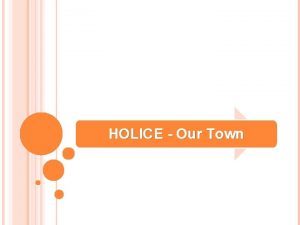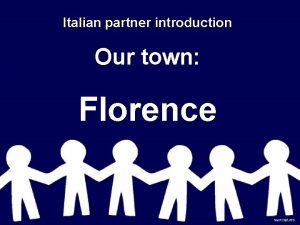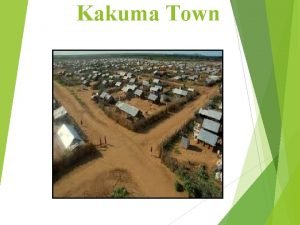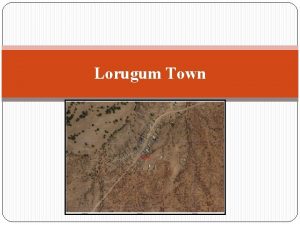Our Town Trikala Celia Manos Location Trikala Greek






















- Slides: 22

Our Town, Trikala. Celia Manos.

Location Trikala (Greek: Τρίκαλα) is a town in northwestern Thessaly, Greece.

Ancient Times Prehistoric Times, Antiquity, Middle Ages, Ottoman period.

Prehistoric Times The region of Trikala has been inhabited since prehistoric times. The first indications of permanent settlement have been uncovered in cave of Theopetra, and date back to approximately 49, 000 BC.

Antiquity The city of Trikala is built on the ancient city Trikke, which was founded around the 3 rd millennium BC and took its name by the nymph Trikke, daughter of Penaus, or according to others, daughter of Asopus river. The ancient city was located between the local hill and the river Lithaios. The city became an important center in Antiquity and it was considered to be the birthplace and main residence of the Healing God Asclepius. The city exhibited one of the most important and ancient of Asclepius temples asclepieia. Additionally, the city was mentioned in Homer’s Iliad as having participated in the Trojan War. In 352 BC it was united with the Macedonia of Philip II. After 168 BC it fell to the Roman Republic.

The statue of Asclepius in the center of Trikala.

Middle Ages Although the area was considered to be constantly under the rule of the Byzantine Empire , it was invaded nevertheless by a succession of raiders and nomadic tribes, such as Slavs, Bulgarians, Normans and Goths. The city's current name is mentioned in the early 12 th-century ”Alexiad” of Anna Komnene. Later in the century, the Arab traveler and geographer Al-Idrisi recorded the town as "an important agrarian center with abundant vineyards and gardens“. After the dissolution of the Byzantine state by the Fourth Crusade in 1204, Trikala does not appear to have fallen into Frankish hands, but became part of the Despotate of Epirus. In 1259, the town was taken without resistance by the Empire of Nikaia. Thessaly was conquered by Ottomans in 1393/4. During Ottoman rule, it was called as “Tirhala”.

The Byzantine Castle

Ottoman Period As the administrative center of the local province (the Sanjak of Trikala), the city attracted Muslim immigrants and had large Muslim and Jewish communities. The city also became an important intellectual center during these years (1543 -1854) with the Trikke School (and later Greek School), where famous intellectuals of the time, such as Dionysius the Philosopher, taught.

Osman Shah Mosque

Modern Period On 23 August 1881 with the Treaty of Constadinople between the Ottoman Empire and the Kingdom of Greece, the city passed in Greek sovereignty, along with the rest of Thessaly. In the years that followed, Trikala played a fundamental role in the rural workers' mobilizations, in the early 20 th century, against the Thessalian landlords (Greek: Τσιφλικάδες). Trikala eventually became the city that the first Agricultural Cooperative of Greece was founded, in 1906. The town lost much of its Ottoman and medieval buildings in the early 20 th century after it was rebuilt to a modern urban plan in the 1930 s.

Neoclassical buildings, in the town centre, in the 1920 s.

SIGHTS

The Old City of Trikala It consists of the districts Varousi and Manavika. Varousi was the Christian district of Trikala during the Turkish rule and is located at the foot of the fortress. Until 1930, this part of the city was considered as the noble district of Trikala and is now preserved in its entirety, with a large number of old buildings, built between 17 th and 19 th century, preserved until today. In this part are located the oldest churches of the city. Following the district Varousi up to the central square is the part of the city called Manavika, a neighborhood of the old city with a uniform architecture. Here are located some of the best restaurants and coffee bars in town.

The Mill of Matsopoulos, is a historical-industrial building and cultural center, which was constructed in 1884. During the Christmas period, the stone-built Matsopoulos Mill transforms into the “Mill of Elves”, a famous Christmas park.

Other Sights • The archaeological site of Asklepieion of Trikke, the most significant and the most ancient of Greece. • The Byzantine Castle, built by Justinian onto the acropolis of ancient Trikke in the 6 th century AD. Later it was rebuilt by the Ottomans, who in the 17 th century placed a huge clock tower, which was accompanied by a bell. In 1936, another clock tower was placed and today remains the trademark of the city, while offers a panoramic view to the city.

• The Osman Shah Mosque (16 th century), building designed by Mimar Sinan. Behind the mosque stands the mausoleum of Osman Shah, nephew of Sultan Suleiman The Magnificent. • The Trikala Train Station, built in 1886, the courthouse and many more historical and neoclassical buildings. • Lethaios and the Central Bridge, built in 1886, which connects the central square with the Asclepius pedestrian zone.

Famous People • • • Dimitris Mitropanos (1948– 2012) singer Vassilis Tsitsanis (195– 1984) songwriter and singer Evangelos Averoff (1910– 1990), politician Georgios Kondylis (1879– 1936) army officer, Prime Minister of Greece Sotirios Kyriakos (1979) footballer Apostolos Kaldaras (1922) popular musician Elias Katsanos (1922) author Kostas Papanikolaou (1990) basketball player Kostas Vivros (1926), lyricist Sofia Sakorafa (1957) javelin's thrower Georgios Koltsidas (1970) footballer

Near-by Destinations • The Meteora is one of the largest and most important complexes of Greek Orthodox monasteries in Greece, second only to Mount Athos. The six monasteries are built on natural sandstone rock pillars, at the northwestern edge of the Plain of Thessaly. The Metéora is included on the UNESCO World Heritage List. • Pertouli is a small mountain village within the province of Trikala and is situated at an altitude of 1, 150 metres on the central part of the Pindos mountain range. Pertouli is most famous for the nearby Ski resort that is very popular with snow sports fans in central Greece.

Pertouli and Meteora.

References/Sources 1) Gregory, Timothy E. (1991). "Trikkala". In Kashdan Alexander. The Oxford Dictionary of Byzantium. Oxford and New York: Oxford University Press. pp. 2115– 2116. 2) Wikipedia, Trikala. 3) http: //www. trikalatourism. gr/portal/page/portal/etrikala/publici nfo/fortress

The End
 Tours in trikala
Tours in trikala Town b is 380 km due south of town a
Town b is 380 km due south of town a Contoh city or town location
Contoh city or town location In our town there were many
In our town there were many Into our town the hangman came
Into our town the hangman came A cross country skier moves from location a
A cross country skier moves from location a Regional factors for location planning
Regional factors for location planning Where did you go for your holiday
Where did you go for your holiday What is measure of location in statistics
What is measure of location in statistics Our location in the milky way
Our location in the milky way Ok 313
Ok 313 Who composed the poem ‘money madness’?
Who composed the poem ‘money madness’? Our future is in our hands quotes
Our future is in our hands quotes Our life is what our thoughts make it
Our life is what our thoughts make it Awareness of ourselves and our environment is:
Awareness of ourselves and our environment is: Thinking affects our language which then affects our
Thinking affects our language which then affects our Awareness of ourselves and our environment is
Awareness of ourselves and our environment is Our census our future
Our census our future We bow our hearts we bend our knees
We bow our hearts we bend our knees Awareness of ourselves and our environment is
Awareness of ourselves and our environment is Our census our future
Our census our future Our awareness of ourselves and our environment.
Our awareness of ourselves and our environment. Our life is what our thoughts make it
Our life is what our thoughts make it










































